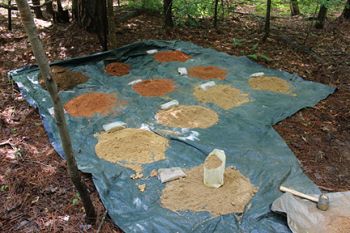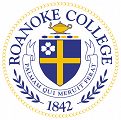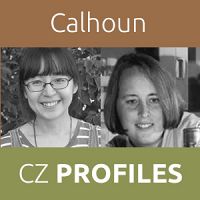Critical Zone Profile - KATHERINE O’NEILL (ecosystem ecologist, Associate Professor)
Katherine O’Neill studies how management practices, disturbance, and land-cover change alter fundamental ecosystem processes, such as cycling of nutrients, soil organic matter storage, and soil productivity. The practical objective of O’Neill’s work is to provide landowners, managers, and policy-makers with a basis for the sustainable management of productive ecosystems.
O’Neill’s research focuses on answering three key questions:
- How do disturbance and land-cover change alter rates and patterns of carbon and nutrient cycling at both the local and landscape scales?
- How do interactions between plant and soil communities influence ecosystem processes in transitional landscapes, such as those at forest-pasture or urban-rural boundaries?
- How can we develop and apply indicators of ecosystem function to better monitor processes within the Earth’s critical zone?
Katherine O’Neill and Harry Godwin extract microinvertebrates from soil samples as part of a study of agricultural management impacts on soil ecosystems. Photo courtesy of USDA Agricultural Research Service.
“The primary focus of my CZO work is on undergraduate education, so the issues that are of greatest interest to me have to do with how to best teach Earth and Environmental Science and instill an appreciation for the scientific process in undergraduates.” —Katherine O’Neill
I grew up in a part of Virginia between Washington, DC and Richmond—an area which is in many ways similar to the landscape of the Calhoun CZO in South Carolina. I no longer have family in my hometown and don’t have the chance to return often, but when I last went back, the landscape was almost unrecognizable. My hometown is now a bedroom community for commuters to Washington, DC and northern Virginia. The farms and forests that I remember are now mostly subdivisions and commercial developments. The landscape where I currently live in the mountains of Virginia still retains much of its rural character, but this area is also under increasing pressure for development and resource extraction.
After graduating from college with degrees in Environmental Science and Geology, my first professional position was working with a soil scientist at the USGS. Up until that point, I have to admit that I really hadn’t thought much about soils or the Earth’s critical zone. However, it quickly became clear that this was really where all of the “action” was happening and that focusing on the processes occurring at or near the Earth’s surface was the perfect way to combine my interests in Environmental Science and Geology.
At the Calhoun CZO, we are developing educational materials to introduce undergraduates to critical zone concepts, such as how soil properties change as a function of depth.
Prior to teaching at Roanoke College, I worked as a Research Scientist with the USDA (Forest Service and Agricultural Research Service), where my work focused on developing ecologically-based management plans for forested and agricultural systems. My current research program continues this line of inquiry.
I teach as part of an interdisciplinary Environmental Studies program at Roanoke College, a liberal arts college in Virginia, where my primary focus is on undergraduate education. Courses that I currently teach include: Earth systems science, GIS, Resources and Risks, a freshman seminar on Sustainability and the Land Ethic, and the senior capstone. I have also developed a course in Critical Zone Science and Management that will be taught in the near future.
When I speak with students or community groups, the term ‘critical zone’ immediately evokes a sense of urgency and relevance.
Among my students, there is a growing sense of awareness about the interconnectedness between the health of human and natural systems. My hope is that increased discussion of the critical zone framework within the undergraduate and K-12 curriculum can help make the critical zone part of our shared vocabulary.
CRITICAL ZONE OBSERVATORIES (CZO)
My primary role with the Calhoun CZO is in education and outreach. It should, therefore, come as no surprise that I think education and outreach are key. One of my primary goals is to help disseminate the emerging science from the Calhoun CZO beyond the research community, especially at the undergraduate level.
In particular, I am working to develop a set of interactive, educational modules geared towards undergraduates and advanced high school students that illustrate key critical zone science concepts and place the emerging science from the Calhoun CZO within a historic and spatial framework. In addition to lab and classroom activities, we plan to feature maps, video interviews with researchers, case studies, and links to contemporary CZ issues to help convey some of the sense of discovery and excitement behind the data.
Environmental educators often emphasize the importance of thinking holistically and viewing the Earth as a set of integrated systems. But, too often, our textbooks and activities are designed to reinforce a disciplinary perspective that leaves it up to the students to connect the dots. The critical zone framework reinforces the interdisciplinary, systems thinking that is so critical for our public discussions of “big picture” issues such as climate change, land use/land cover change, and soil and water quality.
The CZO network provides an amazing opportunity for students to explore critical zone processes across a range of different systems. My classes have used data from the Calhoun CZO in our discussions of processes such as accelerated soil erosion and the impact of land management on soil and water quality. My students have also benefitted greatly from the opportunity to visit the Calhoun CZO and participate in ongoing research, scientific discussions, and workshops. My hope is that the educational materials developed as part of this project will provide similar opportunities for other educators and students throughout the region.
:: By Linda Copman, staff writer ::
Katherine O’Neill and Harry Godwin extract microinvertebrates from soil samples as part of a study of agricultural management impacts on soil ecosystems. Photo courtesy of USDA Agricultural Research Service.
At the Calhoun CZO, we are developing educational materials to introduce undergraduates to critical zone concepts, such as how soil properties change as a function of depth.
Visiting researchers tour the Calhoun CZO.
News Category:
RESEARCH |
PEOPLE |
EDUCATION/OUTREACH
Related News
Explore Further








